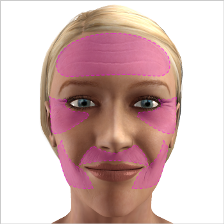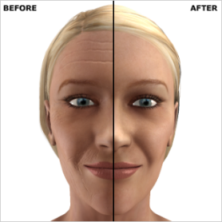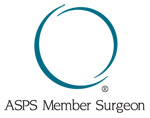Today you have a variety of options when it comes to rejuvenating your appearance. One of the newest is laser resurfacing, which can reduce facial wrinkles, scars and blemishes. Newer laser technologies give your plastic surgeon a new level of control in laser surfacing, permitting extreme precision, especially in delicate areas.
It’s all about using beams of light. Laser skin resurfacing is also known as a laser peel, laser vaporization or lasabrasion. Your surgeon uses the laser to send short, concentrated pulsating beams of light at irregular skin. This removes unwanted, damaged skin in a very precise manner one layer at a time. This targeted approach means there are fewer problems with hypopigmentation, or a lightening of skin for procedures such as laser acne scar removal.
The laser beam used in laser resurfacing will remove your outer layer of skin, called the epidermis. It simultaneously heats the underlying skin, called the dermis. This action works to stimulate growth of new collagen fibers. As the treated area heals, the new skin that forms is smoother and firmer.
Laser resurfacing can improve minor facial flaws, such as:
- Fine lines or wrinkles around or under your eyes, forehead or mouth
- Scars from acne or chickenpox
- Non-responsive skin after a facelift
- Aged or sun-damaged skin
- Liver spots
- Improve your complexion if you have yellowish or grayish skin tones
- Warts
- Birthmarks such as linear epidermal nevi
- Enlarged oil glands on the nose
 For best results, your plastic surgeon may first start you on a series of skin treatments to prepare your skin for your laser procedure. Often these treatments begin 6 weeks or more before your scheduled procedure. These skin treatments are customized for your particular skin type to minimize complications and obtain the best result from your laser resurfacing.
For best results, your plastic surgeon may first start you on a series of skin treatments to prepare your skin for your laser procedure. Often these treatments begin 6 weeks or more before your scheduled procedure. These skin treatments are customized for your particular skin type to minimize complications and obtain the best result from your laser resurfacing.
Cosmetic laser resurfacing is usually done on an outpatient basis and typically takes between 30 minutes and 2 hours.
Managing your discomfort: Laser skin resurfacing can be painful. This is why your doctor may numb the skin with local anesthetics. You may also receive a sedative to help you relax. If you are opting for extensive resurfacing, or if you’re having other cosmetic procedures simultaneously, your surgeon may use a general anesthetic. Afterwards, the doctor will provide painkillers to keep you comfortable. In preparation, your face will be thoroughly cleaned and you might be given eye protection.
Two types of lasers are commonly used in laser resurfacing: carbon dioxide (CO2) and erbium. Both work to vaporize superficial, damaged skin cells.
CO2 laser resurfacing
For year doctors have used CO2 lasers to treat various skin conditions. A newer generation of CO2 lasers has the power to deliver very short pulsed light energy (called ultrapulsed) or continuous light beams. This type of laser precisely removes thin layers of skin with minimal damage to your surrounding tissue.
Erbium laser resurfacing
This type of laser wrinkle removal is typically used to remove superficial and moderately deep lines and wrinkles on your face, but can also be used on your neck, chest or hands.
After the procedure
After laser resurfacing is completed, your plastic surgeon will apply specialized dressing to protect the treated tissues. Further dressing changes or specialized topical treatments may be needed to enhance healing.
 Skin that’s treated with laser resurfacing may react in different ways. But most of the time, it will feel like a mild sunburn. You’ll have some redness and swelling. You may also experience itching or stinging for a few days after the procedure.
Skin that’s treated with laser resurfacing may react in different ways. But most of the time, it will feel like a mild sunburn. You’ll have some redness and swelling. You may also experience itching or stinging for a few days after the procedure.
Depending on the treatment, some people may have what looks like a severe sunburn. The skin will be raw, oozing and may even blister. A yellow liquid may ooze from treated areas to form a crust. Do not scratch or pick at crusts because this can cause scarring.
Usually, about five days to a week after laser skin resurfacing, your skin will become dry and peel.
To achieve an optimum look, follow these steps as part of your recovery:
- Clean the treated areas two to five times a day with saline or a diluted vinegar solution as directed by your plastic surgeon.
- Apply protective skin care treatments that are recommended by your doctor to help your skin heal.
- After healing, you’ll need to use sunscreen, particularly one that’s formulated for the sensitive, rejuvenated skin on your face. Every day. No exceptions! Your plastic surgeon will help you select the correct type of sunscreen to best protect your treated areas.
- If directed to do so by your plastic surgeon, use a liberal amount of moisturizer each day on your new skin.
You can expect that the treated area will peel. After that, the new, rejuvenated skin will be pink, but it will gradually lighten over two to three months. It may take up to a year for the pinkness to go away. It is very important to protect your skin during this time of healing. Redness tends to last longer in blondes and redheads.
You may resume application of Retin-A and/or glycolic acid products around six weeks after laser resurfacing or as directed by your physician.
Complications of laser skin resurfacing can include:
- Acne flares. Your doctor will recommend a treatment regimen.
- Bacterial infection. Your doctor may recommend taking an antibiotic prior to the surgery and afterwards.
- Cold sore reactivation. This may occur if you have laser resurfacing around your mouth. Be sure to tell you doctor about your history of cold sores (herpes). You can prevent the reactivation by taking an antiviral medication before and after the procedure.
- Hyperpigmentation. It’s possible the treated area can become darker in tone. Your physician may recommend a bleaching solution. More rarely you may have hypopigmentation, a lightening of the skin tone.
- Milia. These small white bumps may appear during healing. They can be removed by gentle cleansing with a washcloth.
- Prolonged redness. For some people, the redness just takes longer to disappear.
- Scarring. This is rare, but possible.
- Swelling. If you are having laser skin resurfacing around your eyes, your doctor may prescribe oral steroids to manage this swelling.
Tips for an easier recovery:
- Elevate your head with an extra pillow at night.
- Use an ice pack during the first day or two to ease swelling and discomfort.
- Stop smoking. Tobacco smoke will complicate the healing process.
Recovery times will vary depending on your treatment:
CO2 laser resurfacing: Generally up to two weeks.
Erbium laser resurfacing: One full week.
Camouflage the pink or red skin
Once your treated areas have healed, makeup may used to tone down the color. Try a green-based makeup to neutralize red color. Be sure to opt for an oil-free makeup.
 It’s possible that your skin may stay red or pink for up to several months after laser skin resurfacing. You may also be extra sensitive to sunlight for up to a year. Make efforts to minimize sun exposure and use that sunscreen liberally, every day.
It’s possible that your skin may stay red or pink for up to several months after laser skin resurfacing. You may also be extra sensitive to sunlight for up to a year. Make efforts to minimize sun exposure and use that sunscreen liberally, every day.
Some people who have laser resurfacing may see an immediate difference in the treated skin. That will continue to improve for up to a year. While the effects of laser resurfacing can last for many years, the normal aging process means that wrinkles and expression lines will reoccur. You may repeat laser resurfacing as necessary.
Cost is always a consideration in elective procedures or treatment. The cost for laser skin resurfacing may vary based on the expertise and qualifications of the person performing the treatment, the type of procedure used, time and effort the procedure or treatment requires, as well as geographic office location. In 2009, the American Society of Plastic Surgeons estimated national surgeons’ average fees were $1,167 to $2,193 depending on the type of laser skin resurfacing. Many plastic surgeons offer patient financing plans, so be sure to ask.
Additional fees may include:
- Surgical facility costs
- Anesthesia fees
- Prescriptions for medication
Be sure to ask your surgeon about all costs involved in your procedure.
Your satisfaction involves more than a fee.
When choosing a plastic surgeon for laser skin resurfacing, remember that the surgeon’s experience and your comfort with him or her are just as important as the final cost of the procedure.
Most health insurance does not cover cosmetic surgery or its complications.
- Are you certified by the American Board of Plastic Surgery?
- Were you specifically trained in the field of plastic surgery?
- Is the office-based surgical facility accredited by a nationally- or state-recognized accrediting agency, or is it state-licensed or Medicare-certified?
- Am I a good candidate for laser skin resurfacing?
- What will be expected of me to get the best results?
- Who will perform the laser skin resurfacing procedure?
- Have they been specifically trained in this procedure?
- Where and how will you perform my procedure or treatment?
- How long of a recovery period can I expect?
- What are the risks and possible complications associated with my procedure?
- How can I expect to look over time?
- Do you have before-and-after photos I can look at for this procedure?
- What results are reasonable for me?
It may not be the best choice if you have:
- Active acne
- Very dark skin
- Deep wrinkles
- Excessive or sagging skin
Patients with darker skin tones have a greater risk of healing with darker pigmentation (hyperpigmentation). This may be minimized by use of a bleaching agent after laser skin resurfacing as well.
To find a qualified plastic surgeon who performs laser skin resurfacing, visit the online referral service of the American Society of Plastic Surgeons (ASPS). ASPS, founded in 1931, is the largest plastic surgery organization in the world and the foremost authority on cosmetic and reconstructive plastic surgery. All ASPS physician members are certified by the American Board of Plastic Surgery (ABPS) or the Royal College of Physicians and Surgeons of Canada.

Caution: In the wrong or inexperienced hands, laser resurfacing can be dangerous. In addition to seeking a doctor who is trained and qualified in facial plastic surgery, make sure the physician has specific experience with this type of procedure. Even though the laser therapy may ultimately be delivered by another healthcare professional in the surgeon’s office, it will be with the surgeon’s close supervision.
 3510 N. Ridge Rd, Suite 100
3510 N. Ridge Rd, Suite 100